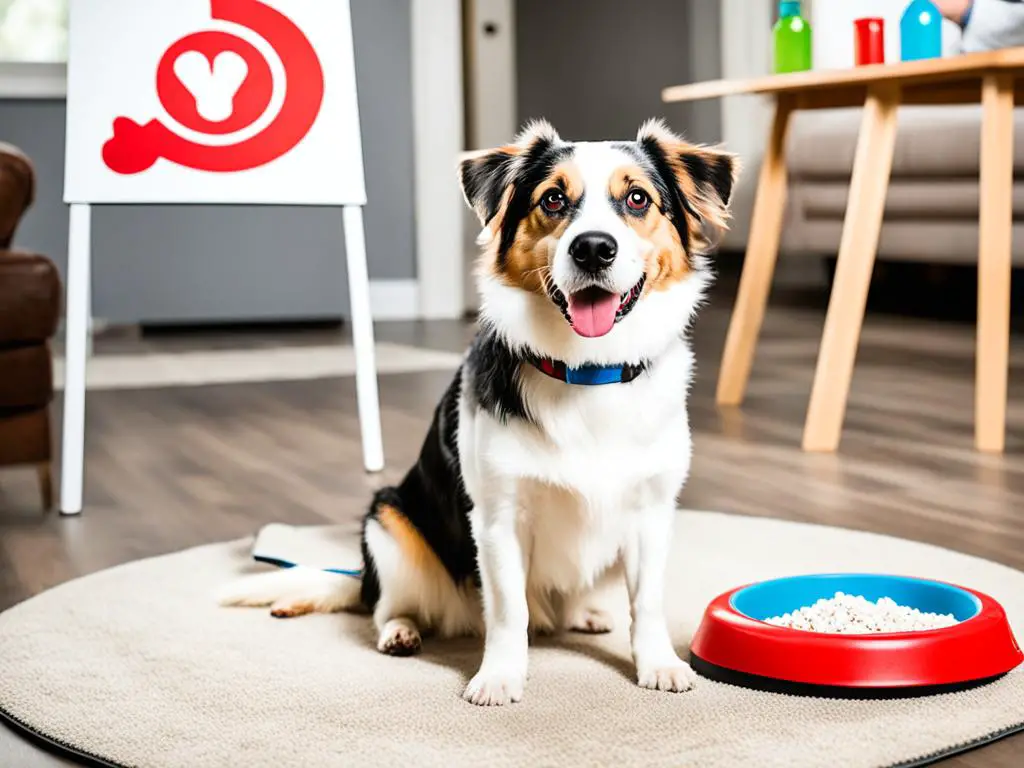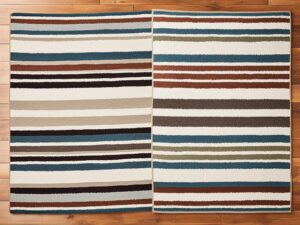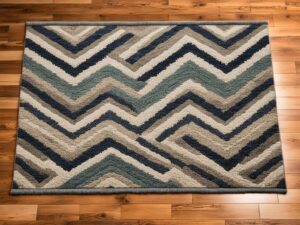Dealing with a dog that constantly pees on the rug can be frustrating. Punishing the dog is not the solution, as it can make the behavior worse. It is important to understand that peeing in the wrong place can become a habit and requires retraining. This involves establishing a specific toilet area for the dog and thoroughly deodorizing the rug. Patience and consistency are key in breaking this habit.
Key Takeaways:
- Understanding that punishing the dog will not solve the problem
- Retraining is necessary to break the habit of peeing on the rug
- Establishing a designated toilet area for the dog
- Thoroughly deodorizing the rug to prevent repeat incidents
- Patience and consistency are essential in the retraining process
Understanding the Underlying Reasons
Dogs may pee on the rug for various reasons. In the case of a new puppy, it may be due to incomplete house training or unfamiliarity with the environment. Major changes in the household, such as moving or renovations, can also trigger this behavior. Psychological issues or age-related factors like incontinence can also be contributing factors. Identifying the underlying reason is important in addressing the problem effectively.
Common Reasons for Dogs Peeing on the Rug:
- Incomplete house training
- Unfamiliarity with the environment
- Major changes in the household
- Psychological issues
- Age-related factors like incontinence
Understanding why your dog is peeing on the rug is essential for finding the most effective solution. By identifying the underlying reason, you can make targeted changes to prevent this behavior in the future.
If your dog is a new puppy, it is important to guide them through the house training process. This includes establishing a designated toilet area and rewarding them for eliminating in the correct spot. For dogs experiencing major changes in the household, providing extra support and reassurance during the transition period can help ease their anxiety. If psychological issues are suspected, consulting with a professional trainer or veterinarian can provide valuable insights and guidance.
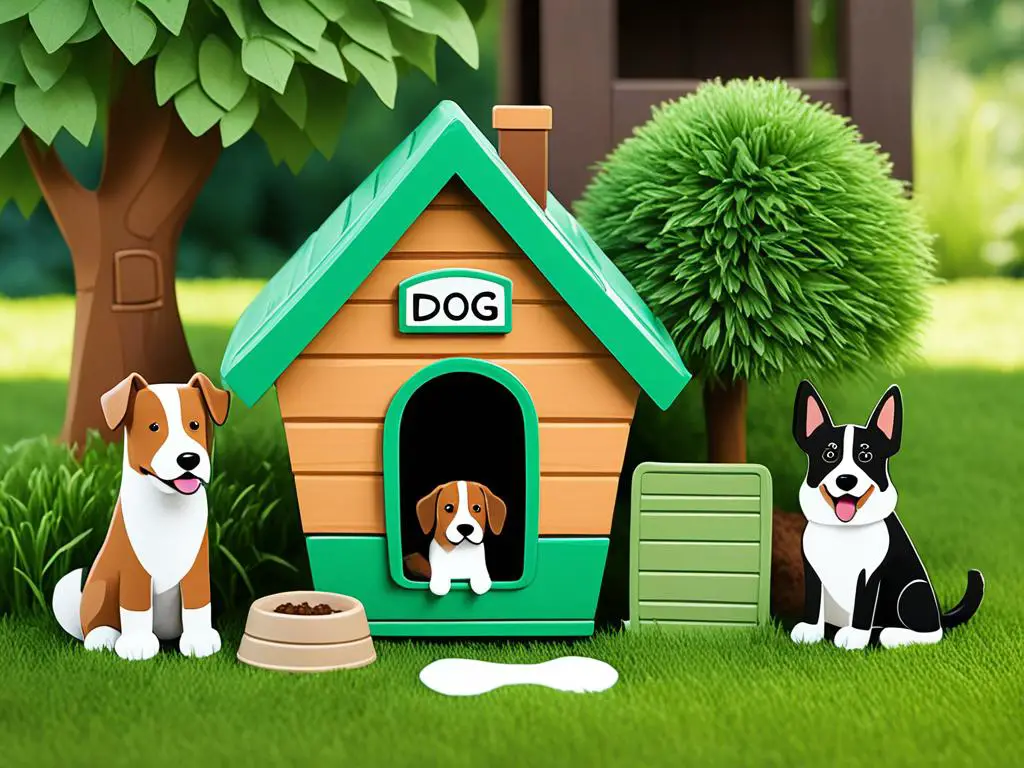
Creating a Toilet Training Routine
Establishing a consistent toilet training routine is crucial in teaching a dog where to go to the bathroom. By following a structured approach, you can effectively housebreak your puppy and avoid indoor accidents.
First, designate a specific toilet area for your dog. This can be a designated spot in your backyard or an indoor training pad. The key is to choose a location that is easily accessible and convenient for both you and your dog.
Next, establish a schedule for taking your dog to the toilet area. Make it a point to bring your dog to the designated spot at regular intervals throughout the day, especially after meals and before bedtime. This consistent routine will help your dog understand where they should eliminate.
When your dog successfully uses the toilet area, be sure to provide positive reinforcement. Reward them with treats and praise to reinforce the desired behavior. This will help your dog associate the toilet area with positive outcomes, further encouraging them to use it in the future.
Consistency and patience are key during the toilet training process. Your dog may have accidents indoors, especially during the initial stages. It’s important to remain calm and avoid punishing your dog, as this can create fear and confusion. Instead, focus on redirecting your dog to the designated toilet area and reinforcing proper bathroom habits.
Remember to be patient with your dog as they learn. Every dog is different, and some may take longer to grasp the concept of toilet training. Stay consistent with your routine and reinforce positive behavior, and soon enough, your dog will become reliable in avoiding indoor accidents.
Tips for Successful Toilet Training:
- Establish a consistent routine for taking your dog to the toilet area.
- Use positive reinforcement, such as treats and praise, when your dog eliminates in the correct spot.
- Be patient and avoid punishing your dog for indoor accidents.
- Stay consistent and maintain a structured approach to toilet training.
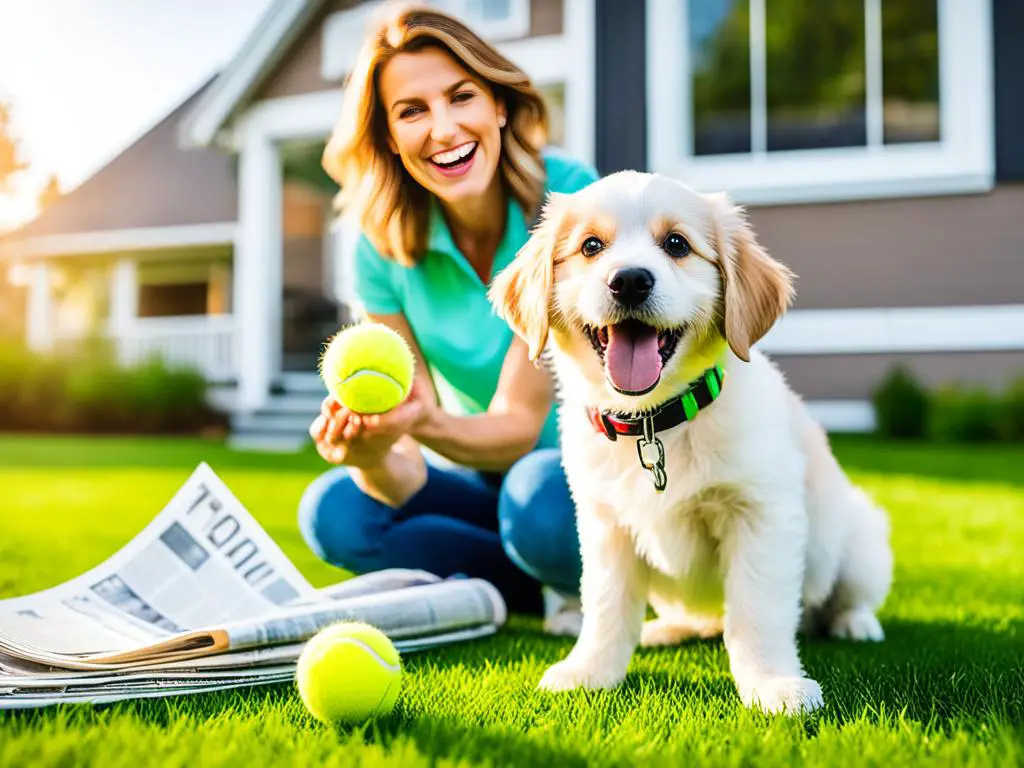
| Benefits of a Toilet Training Routine | Tips for Success |
|---|---|
| Eliminates indoor accidents | Stick to a consistent routine |
| Establishes good bathroom habits | Use positive reinforcement |
| Promotes a clean and hygienic home environment | Avoid punishing your dog for accidents |
| Builds a strong bond between you and your dog | Be patient and understanding |
Managing Accidents and Odor
Accidents are inevitable during the housebreaking process, but it’s crucial to clean them up promptly to prevent your dog from returning to the same spot. Proper pet stain and odor removal is essential in maintaining a fresh and clean home environment. Here are some effective strategies to manage accidents and eliminate odors:
1. Blotting and Cleaning
When your dog has an accident on the rug, start by using paper towels to blot up as much urine as possible. Blotting helps to remove excess moisture and prevent the stain from setting deep into the fibers. Avoid rubbing the stain, as it may spread and further penetrate the rug. After blotting, prepare a cleaning solution using biological washing detergent and water. Gently apply the solution to the stained area, using a clean cloth or sponge to scrub the rug. Rinse the area thoroughly with clean water and blot again to remove any remaining moisture.
2. Neutralizing Odors
To ensure complete pet odor removal, it’s important to neutralize the smell left behind by pet urine. Bicarbonate of soda, also known as baking soda, is a natural deodorizer that can help eliminate odors from the rug. Sprinkle a generous amount of baking soda over the urine-stained area. Leave it on for at least 15 minutes, or overnight for severe odors, to allow it to absorb the odor. Vacuum the area thoroughly to remove the baking soda, taking care to reach deep into the rug fibers.
3. Avoiding Bleach-Based Cleaners
While bleach-based cleaners may seem effective at first, they can actually intensify the urine smell for your dog. The ammonia present in pet urine reacts with the bleach, creating a strong and unpleasant odor that can encourage your dog to mark the same spot again. It’s best to avoid using bleach-based cleaners when dealing with pet accidents and instead opt for pet-safe cleaning products or natural remedies.
| Common Mistakes to Avoid | Tips for Effective Pet Stain and Odor Removal |
|---|---|
| Using steam cleaners or hot water extraction | Blotting the urine with paper towels |
| Applying enzymatic cleaners without proper rinsing | Cleaning the area with a solution of biological washing detergent and water |
| Using harsh chemicals or ammonia-based cleaners | Neutralizing odors with baking soda |
| Skipping the blotting step and going straight to cleaning | Avoiding bleach-based cleaners |
By following these pet stain and odor removal techniques, you can effectively manage accidents and keep your home smelling fresh and clean. Remember, consistency and prompt action are key to preventing your dog from revisiting the same spot. With patience and dedication, you can successfully prevent pet urine odors and maintain a pleasant living environment for both you and your furry friend.
Crate Training as a Solution
Crate training can be a highly effective method for preventing accidents and establishing a consistent routine for dogs. By providing a comfortable and appropriately sized crate for your furry friend, you create a safe and den-like space that dogs instinctively avoid soiling. This helps in preventing accidents indoors and encourages them to hold their bladder until they are taken to the designated toilet area.
To make crate training successful, it’s essential to ensure that the crate is comfortable and inviting for your dog. Use a crate that is spacious enough for them to stand, turn around, and lie down comfortably. Additionally, place bedding, toys, and treats inside the crate to make it a pleasant environment for your dog to spend time in.
When initiating crate training, it’s crucial to establish a routine. Dogs thrive on consistency, so make a habit of taking your dog to the designated toilet area immediately after crate time. This helps reinforce the desired behavior and teaches them to associate bathroom breaks with going outside.
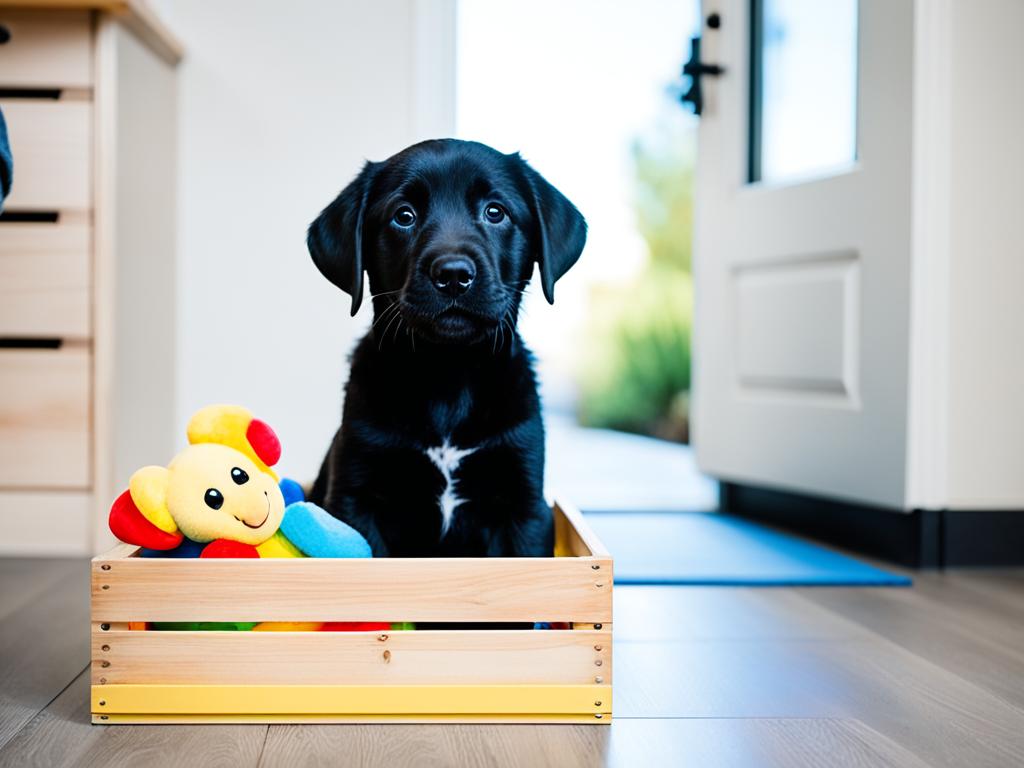
Remember to reward your dog for eliminating in the correct spot. Praising them or giving them a treat every time they do so reinforces the positive behavior and motivates them to continue doing it. Over time, as your dog becomes more reliable with toilet training, you can gradually reduce the amount of time they spend in the crate.
Dealing with Anxiety and Stress
Situational anxiety and stress can greatly impact a dog’s behavior, including peeing on the rug. Understanding and addressing the underlying anxiety is crucial in resolving this issue. By identifying triggers and implementing stress-reducing strategies, you can create a calmer environment for your canine companion.
Identifying Triggers
It’s important to pinpoint the specific situations or events that trigger anxiety in your dog. Common triggers can include loud noises, unfamiliar environments, separation, or changes in routine. By understanding what causes your dog’s anxiety, you can better manage their stress levels.
Stress-Reducing Strategies
There are several effective strategies to reduce anxiety in dogs. One option is to use natural supplements such as Zylkene, which can help promote calmness. Creating a safe and relaxing environment for your dog, with soothing music or a cozy den-like space, can also help alleviate stress. Additionally, incorporating regular exercise and mental stimulation into your dog’s daily routine can provide an outlet for their energy and help reduce anxiety.
“Creating a safe and relaxing environment for your dog can help alleviate anxiety and prevent unwanted behaviors.” – Dr. Samantha Smith, Veterinarian
Consulting a Professional
If your dog’s anxiety is severe or difficult to manage, it may be beneficial to seek guidance from a veterinarian or professional trainer. They can provide tailored advice and recommend additional resources or techniques to help reduce anxiety-related behaviors, including rug peeing.
By addressing anxiety and stress in your dog, you can significantly reduce the likelihood of them peeing on the rug. Creating a calm and supportive environment, identifying triggers, and seeking professional guidance when necessary are crucial steps in managing canine anxiety and promoting overall well-being.
Removing the Rug and Managing Access
If your dog consistently pees on a specific rug, it may be necessary to temporarily remove the rug to break the habit. This will create a disruption in their routine and help redirect their behavior. In the meantime, you can provide an alternative washable mat outside the door for your dog to use as their designated toilet area. This will give them a clear alternative and encourage them to eliminate in the appropriate spot.
In addition to removing the rug, it is important to manage your dog’s access to the area. This can be done by using an exercise pen or baby gate to block off the space where the rug is usually located. By creating a physical barrier, you prevent your dog from reaching the rug and reinforce the idea that it is off-limits.
It’s important to note that preventing access to the rug is only a temporary solution and should be combined with other training methods to effectively break the habit. Providing alternative options for your dog, such as the washable mat, helps redirect their behavior and reinforces the desired toilet habits.
Alternative Options to Rugs for Dogs
If you’re concerned about your dog’s access to rugs or want to explore alternative options, there are several choices available. Consider these alternatives:
- 1. Dog-friendly flooring: Opt for flooring materials that are durable, easy to clean, and resistant to stains and odors. Vinyl, laminate, or waterproof flooring options can be a great choice for households with dogs.
- 2. Area rugs with built-in pee pads: Look for area rugs that have built-in pee pads to protect your floors and make cleanup easier. These rugs are designed specifically for pets and provide a convenient and mess-free option.
- 3. Indoor grass patches: Indoor grass patches are a popular choice for dog owners who want to recreate an outdoor environment for their pets. These patches are designed with a synthetic grass surface and a drainage system to prevent odors.
- 4. Washable pet mats: Invest in washable pet mats that can be easily cleaned and offer a designated space for your dog to rest. These mats are made from durable materials and can withstand accidents and daily use.
By exploring these alternative options, you can create a dog-friendly environment that meets both your dog’s needs and your desire to maintain a clean and odor-free space.
| Option | Description |
|---|---|
| Dog-friendly flooring | Durable, easy-to-clean flooring materials that are resistant to stains and odors. |
| Area rugs with built-in pee pads | Rugs with built-in pee pads to protect your floors and simplify cleanup. |
| Indoor grass patches | Synthetic grass patches with a drainage system to recreate an outdoor environment. |
| Washable pet mats | Durable pet mats that can be easily cleaned and provide a designated resting space. |
Conclusion
Breaking the habit of a dog peeing on the rug requires patience, consistency, and understanding. By addressing underlying reasons for the behavior and establishing a toilet training routine, you can effectively prevent your dog from soiling the rug. Promptly managing accidents and thoroughly deodorizing the area will discourage the dog from repeating the behavior.
In some cases, crate training can be a helpful solution to prevent accidents and establish a reliable routine. Additionally, managing anxiety and stress can contribute to ensuring your dog maintains proper bathroom habits. By creating a calm environment and seeking professional guidance when needed, you can help alleviate anxiety-induced behaviors.
Temporarily removing the rug and providing alternative options can also aid in breaking the habit. Redirecting your dog’s attention with washable mats or blocking access to the rug area will discourage them from peeing in the wrong place. With these strategies in place, you can maintain a cleaner home and successfully prevent your dog from peeing on the rug.
